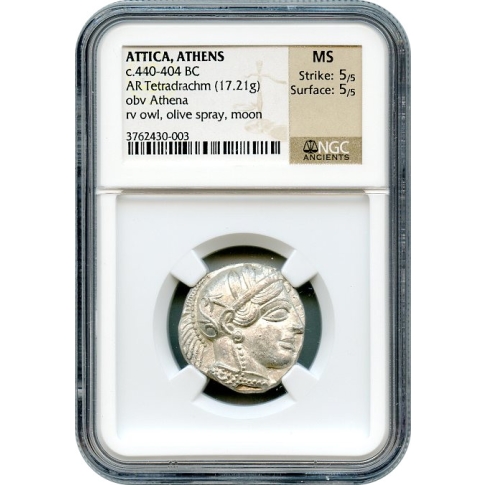Ancient Greece - 440-404 BCE Attica, Athens Owl AR Tetradrachm NGC MS
General and Historical Comments
Mintage of the first archaic type of Athenian owls started around 512 BC and continued through the early fifth century BC. The style transitioned quickly over the next few decades, becoming more refined and artistic, reaching a peak around 460 BC. In 449 BC, during the early Classical period of Greek art, the designs were revised again and production increased exponentially to keep up with the demands from large building projects and the funding of the Peloponnesian War, which started in 431 BC. These later coins are orders of magnitude more common than the earlier issues, and this prevalence allowed Athens to flourish. In addition to their stylistic evolution, the fabric of Athens tetradrachms changed significantly over time, eventually flattening and broadening out into the “New Style” tetradrachms, which were minted in the second century BC.
The Classical tetradrachms of the fifth century BC were made on condensed flans, often with a worn, convex obverse and the reverse owl struck in high relief. When well centered, the owl is shown within a deep concave frame as a result of the shape of the die. The obverse design is often too large for the coins and the crest of Athena’s helmet is usually not shown. The high relief dies also often result in edge splits when struck, due to the force and high metal temperatures involved in the minting process.
This particular coin style is an early “transitional” tetradrachm, part of a group of coins minted from the late 470s through to the early 450s BC, around the same time as the famous Athenian decadrachms. These issues are considered the pinnacle of artistic style in Athenian coinage and many note them as among the most attractive of all Greek coins. President Theodore Roosevelt kept an owl tetradrachm in his pocket and was inspired to order the redesign of the U.S. coinage in the 20th century.
This coin was introduced in the “Pentecontaetia”, the “Fifty Years”, from 479-431 BC during which Athens’ force strengthened, turning it into an imperial power capable of standing against Sparta and her Peloponnesian allies. Stylistically, this coin is dated to the earlier part of this period, followed by a few subsequent changes before the large emissions. Dated 465-462BC, it was likely issued to pay for the Athenian campaign to conquer Thasos in 463 BC. The massive quantities produced after the 431 B.C. “…supplied the civilized world for more than a century.” According to the "100 Greatest Ancient Coins" coffee table issue, “By 406, the city (Athens) had almost run out of silver, and tetradrachms were struck over a copper core as an emergency measure to facilitate locate commerce. These were called “money of necessity” and were immortalized in the play Frogs by Aristophanes:
"Our silver coins, all of purest Athenian make, All of perfect die and metal, all the fairest of the fair, All of the unequaled workmanship, proved and valued everywhere Both among our own Greeks and distant barbarians— These we do not use, but the recent worthless base coins Of vile character and basest metal, now we always use instead."
We've rarely, if ever, encounter examples with perfect symmetry. Instead, astute collectors become fussy over the centering of the design. We have seen one example of a symmetrical coin from this period but not much was hyped about this design quality. This issue is called "the most famous coin of antiquity" for a reason, and being that it is featured as Number 10 in the "100 Greatest Ancient Coins" it has always been extremely popular with collectors. Typically encountered only in Very Fine grades, our exclusive contacts throughout the world have had the amazing good fortune of recently been offered a small group of these coins in a condition that is apparently as close to when they were struck nearly 2,500 years ago as one could possibly expect.
Strike and Surface Characteristics
This issue displays an enormous relief and the design features are usually well struck with strong detail on specimens in high grade. Due to this relief, circulated coins show definitive signs of wear quite quickly and high points are effected, virtually run smooth on most examples encountered. Mint State or Choice About Uncirculated examples are infrequently encountered and usually appear at auction with great interest and fanfare.
| Grading Service | NGC |
|---|---|
| Year of Issue | NONE |
| Grade | MS60 |
| Denom Type | N/A |
| Numeric Denomination | AR Tetradrachm |
| Mint Location | NONE |
| Designation | NONE |
| Circ/UnCirc | Uncirculated |
| Strike Type | Business |
| Grade Add On | NONE |
| Holder Type | N/A |



